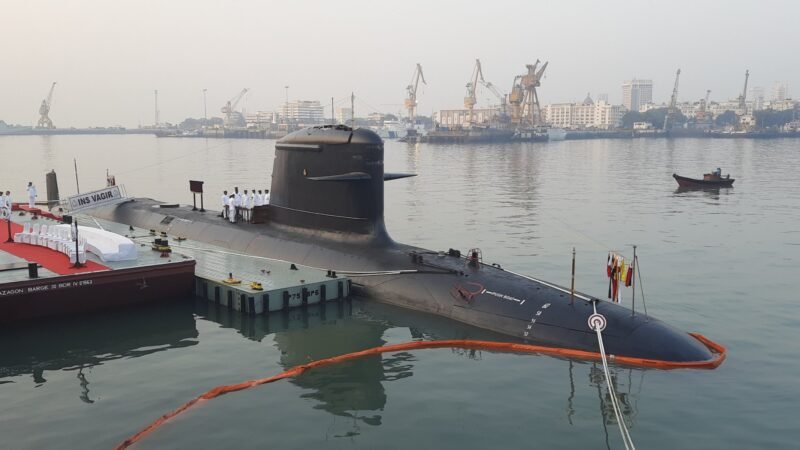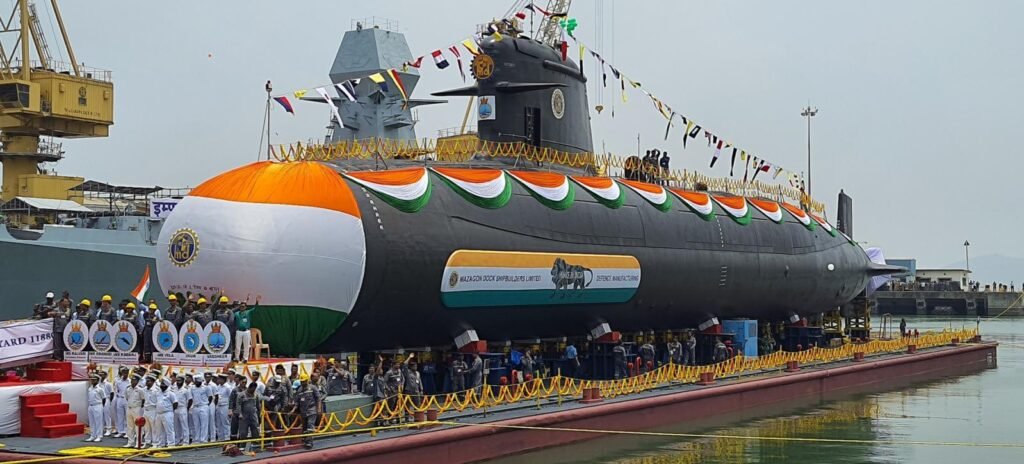Indian Navy commissions INS Vagir: A powerful addition to the Kalvari Class submarines

The INS Vagir, the fifth submarine of the Kalvari Class, was commissioned into the Indian Navy on Monday in Mumbai. The commissioning ceremony was attended by Chief of Naval Staff Admiral R Hari Kumar and other dignitaries. The submarine was built by Mazagon Dock Shipbuilders Limited (MDL) in Mumbai with technology transfer from France, and is the latest addition to the Indian Navy’s fleet.
The INS Vagir is designed to enhance the Navy’s ISR (Intelligence, Surveillance and Reconnaissance) capabilities and special operations capabilities. The submarine is equipped with some of the best sensors in the world, which enable it to detect and track enemy ships and submarines. The Navy has stated that the submarine’s weapons package includes sufficient wire-guided torpedoes and sub-surface to surface missiles to neutralize a large enemy fleet. This makes the INS Vagir a formidable weapon in the Navy’s arsenal and a major deterrent to potential adversaries.
In addition to its offensive capabilities, the INS Vagir is also capable of launching marine commandos for special operations. The submarine’s powerful diesel engines enable it to quickly charge its batteries, making it ideal for stealth missions. The submarine’s design and technology also allow it to remain undetected while carrying out its operations.
The name Vagir means sand shark, which represents stealth and fearlessness, two qualities synonymous with the ethos of a submariner. The Indian Navy has stated that the name was chosen to reflect the submarine’s capabilities and its role in protecting India’s maritime interests.
The INS Vagir is a state-of-the-art submarine that will significantly enhance the Indian Navy’s capabilities and help to protect the country’s maritime interests. The submarine’s advanced technology and capabilities make it a valuable asset for the Navy, and it will play a crucial role in safeguarding India’s security in the region.
What are Kalvari Class submarines?
The Kalvari class submarines are part of the Indian Navy’s Project 75, which aims to develop and acquire six diesel-electric submarines for the Indian Navy. The submarines are designed to be stealthy, with advanced features such as an X-shaped stern and anechoic tiles on the hull to reduce noise levels and improve stealth. They are also equipped with air-independent propulsion (AIP) systems which allow them to stay underwater for longer periods of time without the need to surface for air.
The Kalvari class submarines have a displacement of around 1,565 tons and are 67.5 meters long. They are armed with six torpedo tubes that can launch torpedoes and anti-ship missiles. They also have the capability to launch marine commandos for special operations. The submarine’s sensors and communication systems are advanced, which allows them to detect and track enemy ships and submarines at a long range. They can also be used for intelligence gathering.

The Kalvari class submarines are powered by diesel-electric propulsion, which makes them quieter than nuclear-powered submarines and more suitable for operation in shallow waters. The class is designed to operate in the Indian Ocean and can conduct a wide range of missions including anti-surface and anti-submarine warfare, intelligence gathering and special operations. The submarines are also equipped with a sophisticated combat management system that integrates all the submarine’s sensors and weapons.
The INS Vagir is the fifth submarine of the Kalvari class and was commissioned on Monday in Mumbai. It was built by Mazagon Dock Shipbuilders Limited in Mumbai with technology transfer from France. The commissioning of INS Vagir is a significant milestone for the Indian Navy, as it enhances the Navy’s capabilities in protecting India’s maritime interests and deterring potential adversaries.


















